- Author: Ben Faber
Irrigation efficiency requires not only uniform irrigation, but also the proper timing and amount of applied water. It is important that the irrigator know the system water application rate, either in inches per day, inches per hour, or gallons per hour.
Irrigation scheduling which determines the time and amount of water to be applied can be accomplished through a variety of methods, including measuring soil moisture, determining plant moisture status and determining evapotranspirational loss (ET crop or ETc). Evapotranspiration values are a measure of the actual amount of water well watered plants would use. This information is available in many areas of California from newspapers, irrigation districts, and over the Department of Water Resources CIMIS network California Irrigation Management Information System, or CIMIS Help Line (800) 922-4647).
Evapotranspiration varies seasonally and from year to year for a given location. DWR has developed a map of the average daily ET for various zones in California. These zones are distinctive because total sunlight, wind, relative humidity and temperature are the parameters that drive water loss and differ in each zone. Where the Central Valley becomes hot and cloudless in the summer, along the coast the intensity of the marine layer and its effect on sunshine differs from year to year.
Scheduling, as opposed to a fixed amount applied at a fixed time, is especially important in Southern California coastal valleys. Although the average annual irrigation requirement is about 2 feet of applied water per year (2 acre-feet per acre or 651,702 gallons per acre), this value varies tremendously from year to year, from as little as 18 inches to as much as 3 feet.
One of the most important variables in the quantity of applied water is the length of the rainfall season and the effectiveness of the rainfall. The rainfall season determines the length of the irrigation season and effective rainfall determines how much the plant can use. Effective rainfall is defined as the amount of rainfall, which is retained in the root zone of the tree. For example, consider a rooting depth of 2 feet and each foot holds 1 inch of available water. If you have just irrigated or if it rained 2 inches yesterday and it rains 2 inches today, none of today's rain is effective since the soil was already moist. It did leach salts out, however. Rain events of less than 0.25 inches are also not considered effective.
Determining an irrigation schedule based on tree water requirement falls into three broad categories of technology - plantbased, soil-based and weather-based. Many of these technologies are proven and have been in use for years. Others are more experimental and have not been fully tested. In several cases improved electronics and digitalization have put a new spin on older technologies. A method of determining when to irrigate should be learned by all growers and often a combination of techniques can be employed.
Plant-based Scheduling Methods
The plant is the ideal subject to measure, since it is integrating all the various factors driving water loss as well as soil moisture and any stresses such as soil salinity and plant health. To be a useful tool in irrigation scheduling, plant-based measuring devices must provide indicators of stress before that stress reaches levels that result in yield decreases. The methods include:
- Pressure chamber (pressure bomb or Schollander pressure chamber) measures plant water tension by applying a comparable air pressure to a leaf or stem. The amount of pressure required to equilibrate with the plant sap indicates how much stress the plant is under.
- Trunk diameter fluctuations (shrink/swell), measured continuously with linear variable displacement transducers (LVDTs), can be used to calculate parameters that are directly related to tree stress.
- Stem flow gauge estimates transpiration by placing a heat source on the trunk of the tree and then measuring the temperature differential along a trunk.
- Porometer measures the ability of a leaf to transpire, so when the leaf is under water stress then less water is transpired.
- Infrared thermometry measures the canopy temperature as affected by the rate of transpiration, so as the plant goes under water stress, the leaves gets warmer.
- Visual symptoms (wilting, leaf curling) are the cheapest method, but the most expensive in the long run.
- While these techniques can be valuable for scientific use, there has been little adoption in commercial agriculture. With the exception of the pressure chamber and LVDTs, this is due to the aforementioned problem of being able to identify mild water stress. Another reason for their lack of use by commercial agriculture, specifically subtropicals, is that there are logistical problems with mature trees, such as with the stem flow gauge and infrared thermometry. At this time, the pressure chamber is the state of the art in measuring tree water stress in subtropicals while recent research indicates that the LVDTs show promise for automating irrigation scheduling.
Soil-based Scheduling Methods
A rule of thumb is that irrigation timing should occur when about 50% of the water available to the plant has been depleted from the soil. The 50% figure is arbitrary; it allows a buffer of water in the soil in case the weather suddenly turns hot and windy.
Of course a sandy soil will hold less water than a clay soil, so irrigation will be more frequent. A common perception is that it takes more water to grow plants in sandy soil than clay soil. The total amount required for the whole year by the tree will not be changed by the soil type. This is because it is the sun, wind, temperature and humidity, which decides how much water the tree, will need. The soil is only the reservoir.
To check the water content in the soil, take a trowel, shovel, or soil tube and dig down 8 to 16 inches. A soil that has about 50% available water remaining will feel as follows:
Soil texture
- coarse - appears almost dry, will form a ball that does not hold shape;
- loamy - forms a ball, somewhat moldable, will form a weak ribbon when squeezed between fingers, dark color;
- clayey - forms a good ball, makes a ribbon an inch or so long, dark color, slightly sticky.
Irrigation timing can be determined and also mechanized with the use of a tensiometer. These water filled tubes with a pressure gauge accurately reflect the amount of energy a plant needs to extract water from the soil. The pressure gauge measures "tension values" in centibar units (cbars). When the gauge reads 30 cbars, it is a good time to irrigate.
Placement of the tensiometers requires that they be within the root zone, between the emitter and the tree trunk. Having two tensiometers next to each can be helpful in deciding both when to turn the system on and when to turn it off. A tensiometer at a one-foot depth tells when the water should be turned on and a tensiometer at three feet tells when to turn the system off. Placing a plastic milk crate over the device will prevent pickers from kicking them over.
There are other devices on the market for measuring soil moisture. Gypsum blocks are very effective. Although the part in the ground is inexpensive, the reading device costs in the $250 range. This cost means a large enough acreage is required to spread out the cost of the system.
There are portable meters on the market for measuring soil moisture. These meters rely on an electrical current carried by water in the soil. Even the cheap $10 ones can give a rough estimate of the soil water content. None are very effective in rocky ground, because their sensitive tips break easily.
The amount of water to apply at an irrigation depends on the amount of water held within the root zone. A loamy soil where a microsprinkler with a 20-foot diameter throw has wetted a twofoot depth will hold about 200 gallons of water at 50% of the soils water holding capacity. Exceeding this amount of water will help leach salts; but if far in excess, additional water is only pushing existing water out of the root zone.
It is best to follow one or two irrigation cycles to find out how long to run the system to achieve a certain depth of infiltration. This can be done with a shovel or more easily with a pointed rod or tensiometers. Water moves in a wetting front, and the wetted soil will allow the rod to be pushed in to the depth of dry soil. The system should be run to find out how long it takes water to infiltrate to a depth of two and three feet. That information will indicate how long to run the system when irrigating.
Applying water to achieve a two to three foot depth may take several hours. If run-off occurs, the system may be turned off for a few hours, then turned on again to get the total run time required to infiltrate to a given depth. If run-off is severe, use emitters with a smaller flow rate.
Soil-based methods monitor some aspect of soil moisture which, depending on the method, requires some correlation to plant water use. Some of the methods are well understood and inexpensive, others are expensive, inaccurate, inappropriate or not well researched. Some of the techniques allow multiple site readings while others require a device to be left in place. Some measure soil water directly, like oven-drying and others measure some other parameter with is associated with water content, such as electrical conductance. Some are affected by salts or soil iron content and others have limited value in the desired soil moisture range. Some, like tensiometers and gypsum blocks, give a reading from a porous material, which comes to equilibrium with soil moisture, while many others use the soil directly as the measured media. This is an important distinction since discontinuities in the soil caused by rocks or gopher holes can affect readings when the soil is used to carry a signal. Also, times have changed and some of the old techniques have been improved. For example, gravimetric oven-drying can now be done by microwave, considerably speeding up the process. Tensiometers and gypsum blocks can now be found with digital readouts and connections to data loggers, which make data easier to manage. There are quite a number of devices on the market and the following chart will shed some light on their differences.
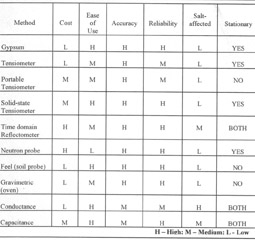
As with any tool, the value of these devices increases with use and familiarity. Even though several of these are listed as stationary devices, by placing them in representative positions in the orchard, they can accurately reflect the rest of the orchard. Several of the devices are listed in the table as being both stationary and portable; this is because there are various models that can act one way or the other. The "Ease of Use" category in the table indicates not just the ease of reading the device, but also the maintenance required for it.
Weather-based Methods of Irrigation Scheduling
Another scheduling technique that has become popular is the use of weather data that has been converted to a crop water use value. This value is the estimated amount of water an orchard would use. The value is often referred to as the evapotranspiration (ET) of the crop. ET is the amount of water that can be lost by a well-watered crop either through the leaves (transpiration) or evaporation from the surface of the soil. By applying the ET amount at an irrigation, the trees are kept at optimum moisture content. The technique is often called the water budget method or checkbook scheduling.
The CIMIS network of over 50 weather stations calculates reference evapotranspiration (ETo). This value is an estimate of the amount of water lost from a well-watered field of grass. Grass is the standard or reference for all other crops. ETo is modified for the specific crop with a crop coefficient (kc). The formula for converting ETo to crop ET is: ETo X kc = ETcrop.
For a full-grown subtropical orchard a kc of 0.65 is used in most of the State, but in the desert growing areas, 0.56 is used. With smaller trees, a smaller kc is used. When trees are young and intercept little energy to drive water loss, a kc of 0.05 works well. As the trees increase in size to where their shade covers about 65% the soil surface, the kc is gradually increased each year. With rapidly growing trees, the kc increase is usually about 10 % each year, until about year 8 when the 65% figure is reached. A correction factor needs to be incorporated for the irrigation system distribution uniformity, as well.
If the orchard is cover cropped for part or all of the year, the period during which the cover is present needs to be recognized in the water use calculation. A soil that is covered by a cover crop and trees uses water just like a mature orchard. Therefore, if the young orchard is covered by a perennial cover crop a kc of 0.65 is used regardless of tree size. If a winter annual cover is used, that uses only rainfall for its growth, correction is not usually necessary in a high rainfall year. But in low rainfall years, the water requirements of the cover need to be recognized in the irrigation program.
Reference evapotranspiration values are available from many irrigation districts, CIMIS, several weekly journals and magazines. In Ventura County, the values are available through County Flood Control, and in San Diego County, they are available from the Resource Conservation Districts.
One of the drawbacks of the centralized weather stations is that in hilly terrain with different sun exposures, the station values can be quite different from the water loss at a grove. When using evapotranspiration figures it is always important to back up the estimates with field checks in the grove. An alternative to using the centralized weather stations is establishing one of your own. These electronic stations cost in the range of $5,000 and require regular maintenance as well.
A simpler weather station can be developed with an evaporation pan or an atmometer (atmosphere meter). Both of these devices actually measure the loss of water due to evaporation and since the physics of evaporation and transpiration are very similar, the values can easily be used in a water budget.
The major drawback to the evaporation pan is the maintenance required to keep birds, coyotes, and bees from causing inaccurate readings. Algae also needs to be kept free of the pool. An atmometer is a closed system with a ceramic head, much like a tensiometer. As water is drawn out of a reservoir, a sight tube shows how much water has been evaporated. The atmometer is more expensive (~$300) than a pan, but it is much easier to maintain.
Regardless of what scheduling technique or combination of techniques is used, a thorough evaluation of the system needs to be performed so that a known amount of water is being applied. Until volume and distribution of water are known, it makes little sense to schedule applications.

- Author: Gary S. Bender
The wildfires in San Diego and Ventura Counties during the fall of 2003 were certainly devastating to many avocado groves adjacent to burning native chaparral. Many of the avocado trees were singed in the canopy without extensive damage to the large scaffold branches; these trees will re-grow new foliage with some relatively minor pruning to clear out smaller dead branches. However, other groves have had extensive damage, complete with charring of the bark in the trunk and boiling of the sap through the bark of the trunk. In these cases, the sap became hot enough to steam the cambium layer (the layer of living cells just beneath the bark), killing the tree above the soil line.
In the latter case, the tree above the soil line is dead, but the roots are still alive. Beginning about the first of March 2004, we have noticed that many of these trees are sending up rootstock suckers near the trunk. If left to grow un-grafted, these suckers will become an avocado tree, but not a known cultivar. The question is: should these burned trees be removed and replanted with a new tree? Or should a sucker be tip-grafted back to a known cultivar?
Sucker grafting in avocado is a well-known practice and has been used extensively in the industry when a grower desired to change cultivars. Generally, the tree is cut down leaving a threefoot stump, which is used as a stake for the new tree. A strong sucker growing from the base of the tree is selected (the sucker should be about 3/4 to 1" in diameter and stiff, not rubbery), and the other smaller suckers should be removed. The sucker is cut with a horizontal cut about 6-8" above the soil line, a 2”vertical slit is made down through the center of the sucker, and 3" to 4" long piece of budwood, cut like an arrowhead at the bottom end, is slipped into the slit, matching the cambium layers together on at least one side, and preferably on both sides. The graft is wrapped tightly with grafting tape, and the entire budstick is wrapped with Parafilm to prevent moisture loss, and grafting tape is used to tie the new grafted sucker to the stump (used as a stake).
Advantages from sucker grafting (as opposed to planting a new tree).
- Sucker grafting is cheaper. As recently quoted by a grafter in Fallbrook, sucker grafting usually costs about $2 per tree after the tree has been cut down to a 3 foot stump. If the grafter supplies the budwood and grafting tape, the price will probably be $2.50 per tree. If the grafter has to travel away from Fallbrook, the price will be higher according to the distance traveled. A new replacement tree will cost about $14 on a seedling rootstock, or $19-22 on a clonal rootstock. The labor cost for planting the new tree would be about $2.00 per tree. These costs do not include cutting down the older burned tree, or follow-up care for the young tree.
- The older, burned avocado tree has an extensive root system with a lot of stored energy. When the sucker graft begins to grow it usually grows very rapidly, much faster than a young replant tree. The sucker grafted tree should start to set fruit two years after grafting.
Disadvantages from sucker grafting.
- We are assuming that the sucker-grafted tree is healthy and does not have root rot or some other disease. If the older tree has root rot, it would be better to remove the old tree and replant with a new tree grown on one of the newer root-rot tolerant clonal rootstocks.
- In the system described above, the trunk is used as a stake. When the new tree grows enough to be selfsupporting, the old stump should be cut down close to the ground. The stump should be slightly sloped to drain water away from the new tree. This takes some careful chainsaw work.
- Suckers. Until the new tree gains strength and starts to shade the old stump, there will be other suckers emerging. These must be removed or they will take over and shade the grafted sucker.
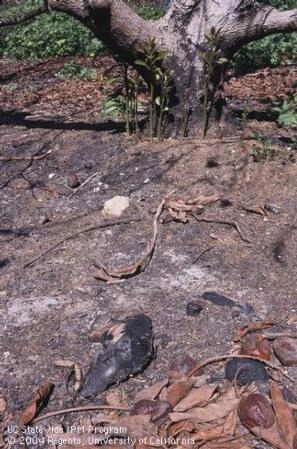 Replant or Sucker-Graft?
Replant or Sucker-Graft?
- Posted By: Chris M. Webb
- Written by: Gary Bender, David Crowley and Mary Lu Arpaia
This is the story of a remarkable avocado rootstock trial that was set up in 2004, lost to the freeze of January 2007, recovered (mostly) and had its first harvest in spring of 2010. But the real story is how some of the rootstocks bore at a really high rate with water that was so saline that almost killed most of our California rootstocks.
As part of Crowley and Arpaia's salinity rootstock trial, in cooperation with farm advisors and several growers, and funded by the California Avocado Commission, this particular trial was planted in 2004 at the Nick Stehly Ranch in Valley Center. The trial had 10 different rootstocks all grafted with Hass scions. Twenty trees of each rootstock were planted in a randomized and replicated block design: the rootstocks were Duke 7, Spencer, Parida, VC 44, VC 207,VC 801, VC 218, PP14 (Uzi), PP 16 (Rio Frio) and PP24 (Steddom). The VC series are rootstocks selected in Israel for tolerance to salinity, and the PP series are rootstocks selected for root rot tolerance by Dr. John Menge at the Plant Pathology Dept., U.C. Riverside. At the time of planting it was not known how the PP trees would react to salinity.
In Spring 2005 we planted six Hass/Dusa trees into vacant spots in the trial. These trees were left over from a Bender irrigation trial on another part of the ranch.
The trees were grown with highly saline irrigation water with an average EC of 2.5 and chloride levels of approximately 300 ppm. Needless to say, most of these trees suffered greatly with severe tip-burn and some of the trees almost died. But some looked better than others and we were waiting for the first harvest. In Spring 2006 some the trees set fruit and we expected the first harvest to be in 2007. But then disaster struck!
In January 2007 we had a serious freeze in San Diego County. Nick Stehly called us to let us know that he recorded a temperature of 18° F in our plot. All of the trees looked like they had died and we gave up on this plot and went on to other trials.
But the irrigators didn't give up! They kept pruning the dead wood out of the trees that did not die and gradually brought most of the trees back to life. But the trees were still being irrigated with the saline water, except for one important difference.
The Stehly family liked to swim in the reservoir about three times during each summer. So they would fill the small reservoir at the end of the ranch that supplied our trial, with Metropolitan Water District water with an EC of 0.7 – 0.9. After swimming they used this water for an irrigation of the trial. Amazingly, this “leaching” irrigation was apparently enough to keep the trees growing without too much tip-burn, and the irrigator reported to Nick in January, 2010 that we had enough fruit for a harvest.
The first harvest was completed in March,2010. The data for mean pounds of fruit per tree is presented in Figure 1. The number of surviving trees after the freeze of 2007 is presented in Table 1.
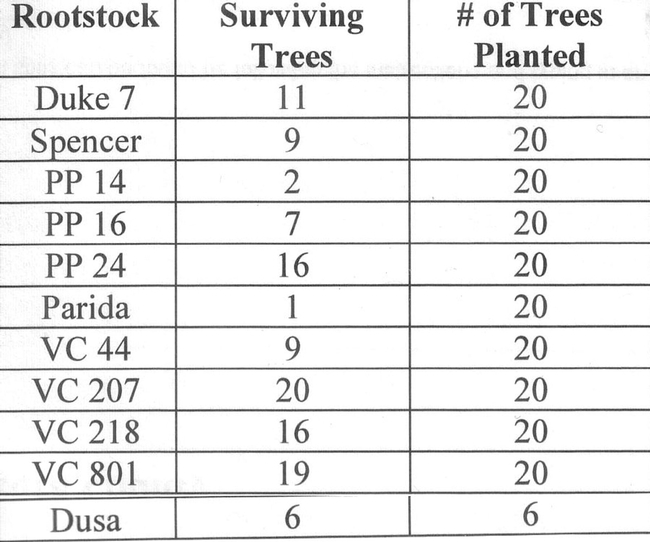
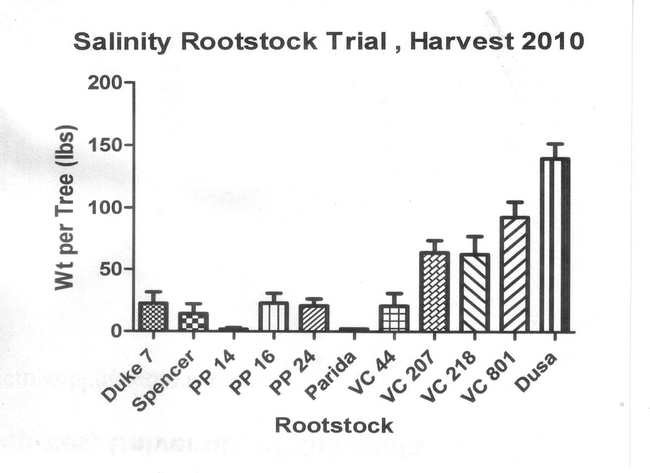
The mean wt of Hass avocados for the VC 801 rootstock was 92.2 lbs, and the mean wt for the Dusa rootstock was 139 lb. If this is compared to the San Diego County average yield of 7000 lbs per acre (about 70 lbs per tree), it would indicate that we might be making progress in finding some better rootstocks for use with some of our saline irrigation waters. However, as we all know, you can't base any conclusions on one year of yield data. We need to have at least three years of yield data to even begin to make a conclusion.
Our hats off to the irrigators at the Stehly Ranch, and to the Stehly family for their cooperation (and their reservoir/swimming pool). You never know what might show up in some of these older rootstock trials.
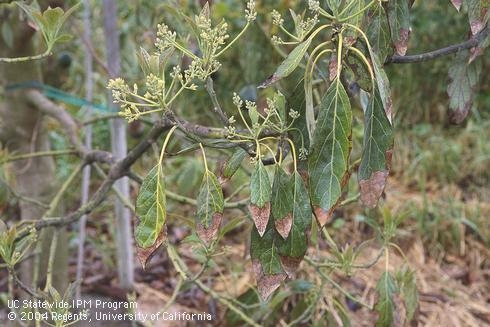
- Posted By: Chris M. Webb
- Written by: Ben Faber
Introduction
In numerous publications world-wide, planting hole recommendations for avocado and other subtropical crops are made for large holes from 2 feet by 2 by 2 to as much as a cubic yard. These recommendations also include incorporation of manures or composts comprising 25% by volume with the native soil. I have noted the use of large holes and amendments in several countries, including New Zealand, Guatemala, Brazil, Costa Rica, Mexico and the United States.
The various reasons given for making these large holes are to disrupt any compaction or limiting soil layers and to create a more conducive environment for root growth. In the case of replanting deciduous orchards, McKenry found it to be beneficial in actually replacing the native soil in the hole with pathogen free soil. In many cases, research has shown that holes much larger than the planting ball and using organic amendments can cause problems for many tree species. Improper mixing of the organic amendment can cause anaerobic conditions and settling due to amendment decomposition. Soil that has not been properly firmed in the hole can also lead to plant settling and stems can drop below grade leading to crown rot.
Nonetheless, on the basis of recommendations made in many countries there could be some value in these planting practices, especially in the light of the effect organic matter has on avocado root rot. Numerous studies have shown organic matter suppresses the causal agent of root rot. This study evaluated the effect of hole size and amendments on avocado growth in an ideal environment with excellent soil conditions and in a more harsh one with heavy soil texture and the presence of the root rot pathogen.
Materials and methods
On the north island of New Zealand in the Bay of Plenty, 20 trees each were planted to one of four treatments: a) small holes (12 by 18 inches) without amendment; b) small holes with 25% by volume compost; c) big holes (60 deep by 30 wide by 24 wide inches) without amendment and d) big holes with 25% by volume compost. Big holes were dug with a backhoe, while small holes were dug by shovel. Trees were approximately 2 feet tall at planting. Soil was a deep sandy loam at both sites. Trees were irrigated by drip irrigation. Trees were ‘Hass’ on ‘Zutano’ seedling rootstock. Trees were planted the second week of spring 2000. Tree height, trunk caliper and canopy volume were measured on a monthly basis for eight months and then twice a year for the next year. In Carpinteria, California a similar trial was established using ‘Hass’ on ‘Toro Canyon’ rootstock. Trees were approximately 2 feet tall at planting. The grove had a heavy clay loam soil and a history of root rot. The trees were on drip irrigation. The trees were planted summer 2001 and monitored for 18 months after planting.
Results and discussion
Figures 1and 2 show the results of the different planting treatments at sites in New Zealand on ideal soils and on the heavy soil infected with root rot in California. Only tree height is shown; trunk girth and canopy volume followed similar patterns. From planting onwards, there were no differences in tree growth in any of the treatments at any of the sites. This would lead one to the conclusion that there is no value in and a great expense in making big holes and incorporating amendment. This is especially so in hillside situations where moving equipment and amendments on steep slopes would be very difficult.
The trees at the Carpinteria site, although infested with root rot, all looked good. The addition of organic matter in conjunction with the clonal rootstocks did not apparently provide any greater disease resistance. This is in accordance with work done by John Menge which shows that the greatest benefit derived from mulching are seedling rootstocks. The effect of mulch on disease suppression diminishes with the rootstock’s resistance to root rot.
Figure 1. Tree height (meters) at site 1 in New Zealand 20 months after planting. No differences were found at the 5% level of significance.
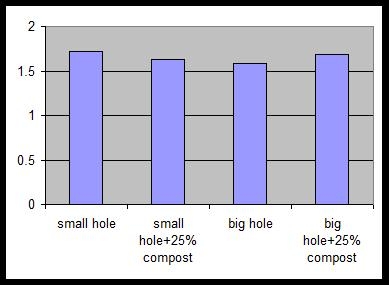
Figure 2. Tree height (meters) in California 18 months after planting. No differences were found at the 5% level of significance.
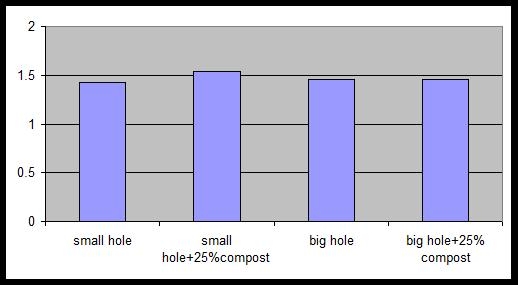
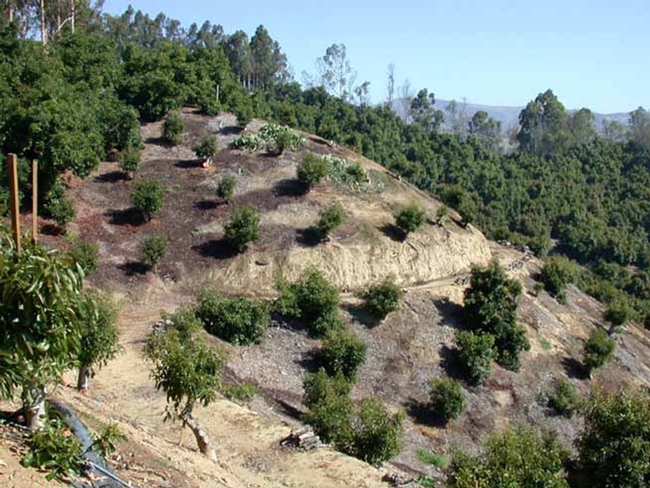
- Written by: Jim Downer
Horticulture is the cultivation of plants as ornamentals or for the production of food. When things go wrong (plants grow poorly or not at all), horticulturists sometimes turn to products that can “cure”, revitalize, invigorate, stimulate or enhance the growth of their plant or crop. A horticultural consultant colleague of mine, has often told me, “There are no miracles!” Unfortunately, when nothing else has worked, many people will turn to so called miracle products in hopes of a cure. Products that purport to give you that miracle are termed snake oil. Snake oil products claim many things, but usually without referenced research reports from Universities. Snake oil products almost always offer numerous testimonials to support their use. Those who provide testimonials are usually not researchers. Professional horticulturists, farmers and gardeners should be able to recognize snake oil products and avoid their use—we should base our horticultural decisions on sound research based information, not on marketing claims and testimonial based admonitions.
Science Based
The most creative and effectively marketed snake oil products often cite sound biological facts or knowledge and then attempt to link their product to this knowledge, but references to the published research about their product are always missing. Very often, snake oil products will use jargon relating to the chemistry, biology or microbiology of their products in an attempt to impress potential users with terms that sound informative but are used in a meaningless context. In some cases, these products are “ambulance chasers” and follow the most recent pest outbreak or natural disaster in an attempt to make money from desperate clients.
Works on a new principle
A prime indicator of snake oil products are that they rely on a new principle that gives them their efficacy. This “new” principle may be entirely fabricated by the manufacturer or have a shred of truth based in current science, but the science is so distorted that there is no truth in the claim. Very often the active ingredient is not listed on the label and is a “secret” or proprietary substance. A clear explanation of the scientific principle, its discoverer, where it was published and how it relates to the product at hand is rarely or never available.
Research Based
Some products make claims of efficacy based on extensive research. But who did the research? Upon inspection, we find that independent, third party research, published in a peer reviewed journal is lacking. In house research or research conducted by contract with other companies may not have the same degree of objectivity as University based research projects. Some products allude to University research but never tell the user that the research found that their product was not effective. Sometimes product literature tells outright lies about the efficacy of the product discussed in the research.
Sometimes a retired researcher will start selling a product based on the good research they have done in the past, but with little bearing on the efficacy of the current product or material. Past affiliations with Universities are no guarantee that products developed after the researcher has left the institution are efficacious. Only current, published reports of efficacy in peer reviewed journals are acceptable references.
Snake oil products can sometimes be lawbreakers!
Products that purport to control a pest such as a disease organism or an insect or weed, but are not registered with the State or Federal EPA and do not have pesticide registration numbers, are not pesticides and can not be used for that purpose. It is a violation of state and federal laws to apply products as pesticides when they are not labeled for that use. Sometimes a product claims to boost plant health and thus avoid diseases, also avoiding the pesticide registration process. Health boosters, activators, and stimulators are not considered pesticides by regulatory agencies; however, they are often not efficacious or supported by University research findings.
It is too good to be true
Some problems like Armillaria (which causes root rot and basal cankers of many ornamental and orchard trees) are essentially incurable. All the traditional sources of information suggest ways to limit the disease but no “cure” is offered. Along comes a product that kills the pathogen and reinvigorates the sick host. Sounds too good to be true? Then the product is probably snake oil. Rarely do efficacious pest management practices or products come to market without some kind of University based research. Again, there are no miracles.
Soil Microbiology Products and Services
All plants have root systems and almost all are rooting in soil, and since we do not see their roots very well, there is a lot of snake oil that concerns soils and soil treatments. Polymers, growth activators, hormones, vitamins, fertilizers, worm castings, composts and their teas, are but a few products that may fall into this category. Since none of these products claim to be a pesticide, the careful efficacy testing required for state or federal registrations is not required. Efficacy claims can run to the extreme.
Mycorrhizal Fungi
Some of the most convincing products are those that have solid scientific basis for efficacy but no direct evidence that they work. A classical example is fungal mycorrhizae forming inoculants for landscape trees. Mycorrhizae are not snake oil. However, some products that purport all the things that mycorrhizae can and do achieve for plants may be. Many of the numerous scientific papers written on mycorrhizal fungi do not indicate that mycorrhizae are necessarily lacking from most soils, or that the products used to add them to soil are viable. In a study of ten commercial mycorrhizae products, Corkidi et al.(2004), found that four of the ten failed to infect the bioassay plants and in a second trial, three of the ten products failed to infect.
Biological control
A considerable amount of time is spent each year by companies producing biological control microorganisms. Although these often show good efficacy in university based laboratory or greenhouse trials, and this research is published, there are few products that show efficacy in field-based trials. Many of the Trichoderma based products simply do not work when applied as products outside the lab or greenhouse. Biological control of soilborne diseases is an elusive thing that we seek to understand constantly, catch glimpses of in the field, study intensively and consistently fail to recreate when and where we want it to happen. Rarely has a single organism been applied with disease control effect in field settings. Soil ecosystem level changes (like massive mulch applications) can promote biological control of root rot diseases, but these effects are caused by many kinds of fungi that are naturally occurring in the environment.
Soil Food Webs
Manipulation of Soil Food Webs is purported to balance all the complexities of soil so that plants will grow well. The concept is to balance the various microorganisms so that the soil will benefit the crop at hand. Lab services are used to diagnose the organism content of a given soil sample. Horticulturists then use this information to make the recommended changes to modify the soil ecology and enhance plant performance. A “healthy soil” will grow healthy plants; a “sick soil” is unproductive. The theory predicts that in poorly managed soils, all the “good” fungi are killed and only the plant pathogens remain. The data relating good fungi to bad and how their populations interact is rarely given and published references with this information are lacking. Detailed information on the interactions of soil food webs with specific plant pathogenic fungi are distinctly lacking in the literature.
Soil food webs are complex. Ferris and others have found that nematodes are good indicators of the status of the soil food web. Since nematodes feed on fungi and bacteria, the two most important manipulators of organic carbon, nematode guilds can be monitored to determine the various successional stages of decomposers in a food web. Maintenance of labile sources of soil organic carbon ensures adequate levels of enrichment for opportunist bacterivore nematodes and thus adequate fertility necessary for crop growth. Labile organic carbon can be supplied by organic amendments or by the roots left behind after a crop is harvested. Organisms come and go in the soil, dependent on carbon available for their growth. If one group (guild) of bacteria or fungi use up the available food, another will take over on what is left. Ferris and others refer to the changes in food web function as functional succession. Analysis of nematode fauna has emerged as a bioindicator of soil condition and of functional and structural makeup of the soil food web. Nematodes are used to assess the food web because evaluation of the food web structure is in itself very difficult; you would have to inventory and assess all of the participants. Functional analysis of the web is difficult because it may not indicate how the various functions are being accomplished or whether they are sustainable. Merely counting bacteria and fungi gives nothing but a snapshot view of what was happening the day the samples were obtained. Since nematodes are the most abundant animal in soils, they can be used as a tool in assessing the structure, function and resilience of the soil food web.This understanding of the biology of soils is new and not yet practicably applicable on a wide basis.
Compost Teas
A natural extension of food web science is the use of compost teas to “strengthen” the food web. Compost teas are “brewed” from compost usually in an aerobic fermenter. They may be aerated or non-aearated. Because the feedstock (compost) is highly variable, the resultant teas can also be quite different. Due to the tremendous number of variables in “brewing” compost teas (ph, fermentation time, water source and content, temperature, added nutrients, feedstocks and aerated vs. not) the results are hard to replicate and quite variable; this makes studies hard to publish. Compost teas contain many different substances plus nutrients that plants can use for growth or that can act as plant growth stimulators. The problem comes with rates. How much do you apply and how often? There is a lot of experimentation going on by the users of the teas but not much validation in the academic community (especially research on trees) due to the variability of these systems.
Horticultural Myths
These are practices and or products that many people working in our industry may hold to be useful but have no scientific basis for their method of action. They are formed from misinformation passed on over the generations or from common observations that are misinterpreted. A good example is that of placing gravel or rocks in the bottom of a planting hole to increase drainage for the rootball. This is borne out by the fact that these drawings exist in old books. Even though the mistakes are corrected in modern texts the myth that rocks in the bottom of a planting hole creates drainage, lives on today, and actually shows up in some modern landscape architectural specifications.
Another myth is the notion that pruning woody plants stimulates their growth. The more severe the pruning, the more the plant is shocked into good growth. Although the growth of latent buds from major limbs that have been headed back leads to copious regrowth, if you compare the overall growth of this tree to a similar unpruned tree, the pruned tree will have grown less on the main trunk over the same amount of time. Transplanted trees do not need to be pruned to compensate for their root loss. Sometimes when trees are moved, compensatory pruning is done to “balance” the roots with the shoots. Research has consistently shown that as mentioned above, pruning is a growth retarding process, and thus slows the establishment of transplanted trees.
There are many funny ideas about mulches. Almost any mulch can be applied to the soil surface with few bad affects. There are some exceptions where the mulch contains toxic acids or contains weed seeds. However, the belief that high C:N ratio mulches (contain a lot of wood) will extract nitrogen from under the soils to which they are applied has little or no scientific evidence to support it. Just the opposite is true. Over time, woody mulches decay and release nitrogen to underlying root systems.
A product that has attained Horticultural Urban Legend status is Vitamin B1. In the 1930's, Caltech's James Bonner discovered, that Thiamin (vitamin B1) was able to restore growth to pea root tips that had languished in tissue culture. It was concluded to be essential in plant growth media. Bonner later found that B1 had little growth promoting effects on most whole plants in hydroponic culture, but that some plants such as camellia, and cosmos showed dramatic growth increased to added B1 vitamins. Bonner latter discovered that thiamin production was associated with the foliage of growing plants. The hoax was on in 1939 when Better Homes and Gardens magazine ran an article that claimed thiamin would produce five inch rose buds, daffodils bigger than a salad plate and snapdragons six feet tall! In1940, Bonner entered into collaborative research with Merck pharmaceutical company to master the growth promoting effects of B1, account for the wide variability in his experimental results and develop a product that gave consistent good results. Bonner proved during this period that B1 was phloem mobile was made in leaves and transported downward in stems. Bonner's experiments with Cosmos continued, but with varying results, so he sought cooperative research with University experiment stations around the country. Results were mixed, some showed growth promotion, most not. By 1940,other physiologists widely reported negative results. By1942 Bonner was debunking his own discoveries, stating that the effect only ever occurred in very few plants and that since thiamin was found in soil itself, field applications were unlikely to benefit plants. Bonner ultimately fully retracted his claims of efficacy by saying “It is now certain, however, that additions of vitamin B1 to intact growing plants have no significant or useful place in horticultural or agricultural practice”. The public craze and fanatical headlines about thiamin continued but Merck withdrew all interest and funding in the concept so as to distance itself from a product that does not work.
Conclusions
New products come and go. Snake oil products often disappear rapidly, when their efficacy fails to materialize after application. Products that confound their purported results with fertilizers or growth stimulators can persist, but eventually they too fail to live up to expectations at some point and will fade from popularity. Try to obtain some kind of consensus with university based research or other peer reviewed research reports, field efficacy trials that you run for yourself, and not on the testimonials of others. If you decide to conduct your own trials, they must be replicated and statistically analyzable, otherwise they are little more than anecdotal observations that have little value in quantifying the effects of the above mentioned products and practices. For more help with trials, seek out University Extension agents and specialists. This is their job, and they are willing partners in field research. After awhile, you will be able to ascertain the nature of the “oil” before you purchase it.




